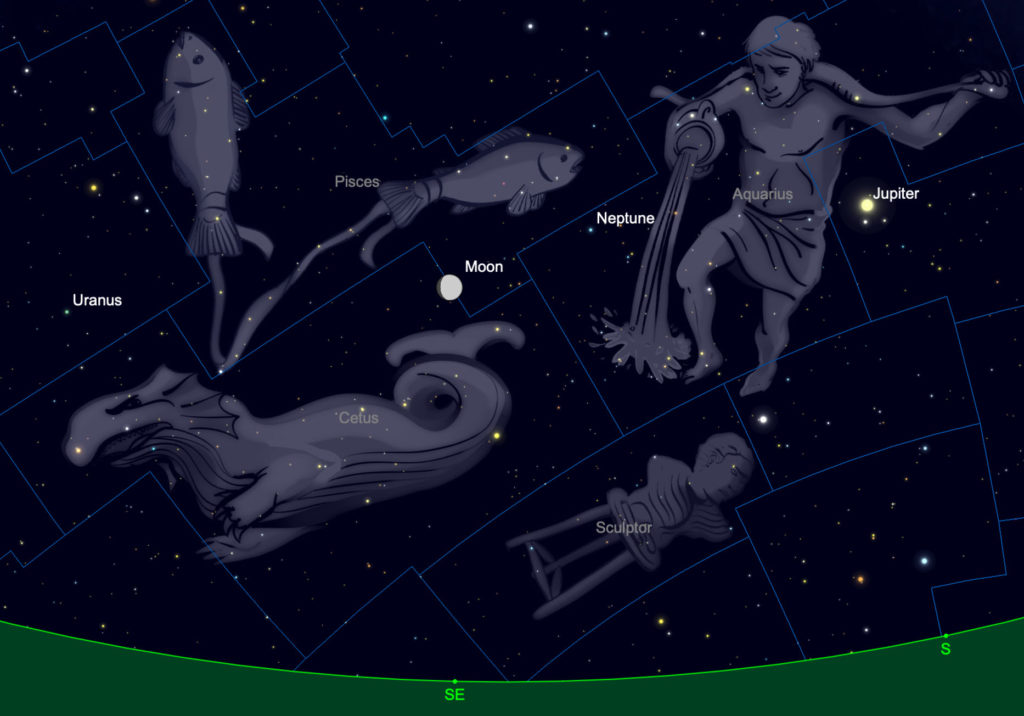Sky Report: November 8 – November 14

Cetus is low in the southeast. The blue lines mark the modern constellation boundaries. At 7 p.m. standard time on the 14th the moon has just crossed the Pisces-Cetus boundary. During the next 24 hours the moon moves eastward against the background stars until it returns to Pisces, then to cross their tails. Of course the boundaries are arbitrary (so are the constellations!) and you can draw them any way you wish, and at one time people did – to great confusion, but these are the universally-accepted astronomical boundaries by international agreement.
Graphic created with SkySafariAstronomy.com.
The moon is nicely placed for observing this week, moving eastward day-by-day (or night-by-night) in the evening sky. It begins this week in the summer constellation Sagittarius and moves through the autumn constellations Capricornus, Aquarius, and Pisces – and ends the week in Cetus! Cetus, the Whale or Sea Monster, is not a constellation of the traditional zodiac, but the moon cuts across a corner of it now and then according to the way modern astronomers divide the sky into 88 official constellations. The moon is in Cetus for only one day, from about 6:30 p.m. on the 14th until about 6 p.m. on the 15th.
Cetus was recognized by the ancient Greeks who got it from the Babylonians, so it’s not a new invention.
Along the way the moon is in the vicinity of Saturn on the 9th and 10th, below Jupiter on the 11th, and below Neptune on the 13th, but it’s not especially close to any of them.
The constellations Capricornus, Aquarius, Pisces, and Cetus lie away from the Milky Way and consequently have no bright stars. You may not see them at all from urban areas and even from dark locations they do not have easily-recognizable star patterns. BTW, by far the best way to learn the constellations is to have someone who knows them point them out to you; it’s tricky to teach them to yourself with printed charts or even a smartphone.
Don’t forget brilliant Venus, the brightest object in the night sky after the moon, which is low in the southwest at sunset. Venus sets 2½ hours after the sun.
Mercury and Mars are both in the morning sky; Mercury is leaving as it moves more nearly in line with the sun while Mars is reappearing to view after having been behind the sun. They pass on the morning of the 10th and if you like a challenge, look for them then with binoculars or a wide-angle telescope. Mercury will be reasonably bright very low in the east-southeast in early morning twilight while Mars is much fainter and only 1° to the right of Mercury. Mars is very hard to spot now, being both faint and still close to the sun, but it rises earlier each morning and very slowly brightens, and 13 months from now it will rise at sunset and will rival Jupiter as the brightest planet.
Under a grant from the Utah Governor’s Office of Economic Development and the Kane County Office of Tourism, Stellar Vista Observatory offers portable telescopes and tripod mounted binocular kits on loan for free to all residents of Kane County. Nothing beats a quality binocular or astronomical telescope to enhance enjoyment of the night sky! Visit https://stellarvistaobservatory.org/discover-the-night-sky/ or Kanab City Library for full details.
The Sky Report is presented as a public service by the Stellar Vista Observatory, a nonprofit organization based in Kanab, Utah, which provides opportunities for people to observe, appreciate, and comprehend our starry night sky. Additional information is at www.stellarvistaobservatory.org. Send questions and comments to John@StargazingAdventures.org.






Comments are closed.